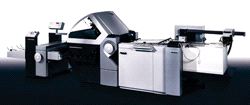Finishing & Screen Printing
Automated folding equipment from Heidelberg puts users on fast track to success

Thursday 30. January 2014 - Commercial printers and trade binderies aiming to replace antiquated folding equipment are turning to Heidelberg for fast, highly automated folding solutions designed to minimize labor, shorten makeready and changeover times, and increase net output. The Stahlfolders of Heidelberg's TH/KH generation deliver the quality and speed that buyers now expect of print shops and binderies.
Good-bye to OT
“At the end of the day, it’s about incrementally decreasing labor through automation,” said Taylor Blackwell, president of Walker 360, a full-service advertising and marketing communications company in Montgomery, AL. The company recently installed a highly automated Stahlfolder TH-56 4/4 pile-fed folder to take advantage of faster makereadies on shorter runs (<500) of commercially folded and signature work. The configuration features a preslitter shaft, rear-mounted slitter shafts in the first station, and SAK stream delivery. "Since the new folder became operational, we've reduced overtime and significantly increased our throughput," Blackwell said.
Heidelberg TH/KH Stahlfolders are available with Level I, Level II, or Level III Automation. Level I lets an operator select fold configuration via touchscreen, inputs the length and width of the sheet, and loads them into the program, which calculates the fold and presents plate, fold roller, and all guide settings to the operator. Level II adds automated simultaneous fold roller pressure settings in each station, while Level III combines the advantages of Level I, Level II with automated folder plate positioning to achieve optimal makeready times. Each level enables users to conveniently save and reload jobs.
Spare the Elbow Grease
Vedda Printing+, Cleveland, Ohio replaced a pair of aging folders with a Stahlfolder KH-82 knife folder equipped with pallet-fed feeder and integrated rear-mounted slitter shaft. Level III automation includes touchscreen operator guidance, automated fold roller settings, and motorized buckle plate settings. According to Vice President of Operations Ron Jewett, extensive automation on the new folder enables Vedda to maximize existing manpower by dramatically cutting makeready times and boosting speeds up to 18,000 sph on folded signature work. “Investing in new equipment is easier to justify when you look at makeready savings, a higher net output, and the ability to provide quicker turnaround times,” Jewett said.
Heidelberg’s high-performance, pallet-fed feeder enables the folder to run with one operator at a higher net speed, with a minimum of bending and lifting. As a result, the operator can tend to the delivery and also have time to check his quality during production.
Heidelberg’s TH/KH generation folding machines are available with a choice of flat-pile feeder, round-continuous feeder, or pallet feeder to suit any requirement. Options include the new, PFX (Pallet Feeder eXtended), which can boost a folding machine’s output by up to 50 percent compared with conventional cross-fold production. A choice of deliveries includes simple stream, vertical or horizontal-pile, and the high-performance, automated palamides delta system. The compact, automated KH-82 also requires less space than a typical buckle machine.
The Winning Score
McCarty Printing Corporation, Erie, PA, one of the longest established commercial printing firms in Northwest Pennsylvania, also credits a new Stahlfolder KH-82 from Heidelberg with increasing the efficiency of its folding department. The new machine, which replaces an older model Stahlfolder, enables faster setup and more accurate and efficient scoring. “Technology makes all the difference,” said company spokesman Don Frank. “Our operators love the user-friendly on-screen programming, which automatically calculates the correct feeding parameters of the machine. The safety features are also state of the art.” An extra mobile, height-adjustable VFZ 52 four-way knife-folding unit can be used to execute a final cross-fold, as needed.
All Stahlfolder TH/KH models share a modular control system whose simple symbols and graphical displays provide a quick overview of all machine functions. An optional Automation Kit permits all machine settings to be selected using the central touchscreen. New jobs can be loaded into the machine if wished from the integrated fold library, via Compufold, or directly from the production workflow via Prinect FCS 100. Individual folding units also can be programmed with the aid of graphical representations of fold types on the touchscreen. This functionality extends to the creation of intricate specialty folds previously requiring lengthy manual adjustment.
“Customers now recognize the benefits of automation and technology in the bindery and are investing to compete in the overall market,” concluded Steve Calov, postpress product manager, Heidelberg USA. “The demand for shorter runs and quick turnarounds, combined with tighter margins, requires printers and trade binderies to change the way they run their businesses. Efficient automation and ease of use are the keys to eliminating duplicate effort and unnecessary material handling.”
All in the Family
Heidelberg’s TH/KH platform permits the folding machine to be assembled precisely to meet the needs of each user. The feeder and first folding unit can be equipped with different modules and easily modified if the job mix changes. The advantages of this modular concept are obvious: the basic machine configuration is not fixed forever, allowing the addition of optional features for maximum flexibility. Complete integration of these folding machines in both the production line and the management workflow makes job handling much more transparent. Once captured or defined, production data can be used throughout the process. This taps additional potentials for realizing savings while making production more reliable.
